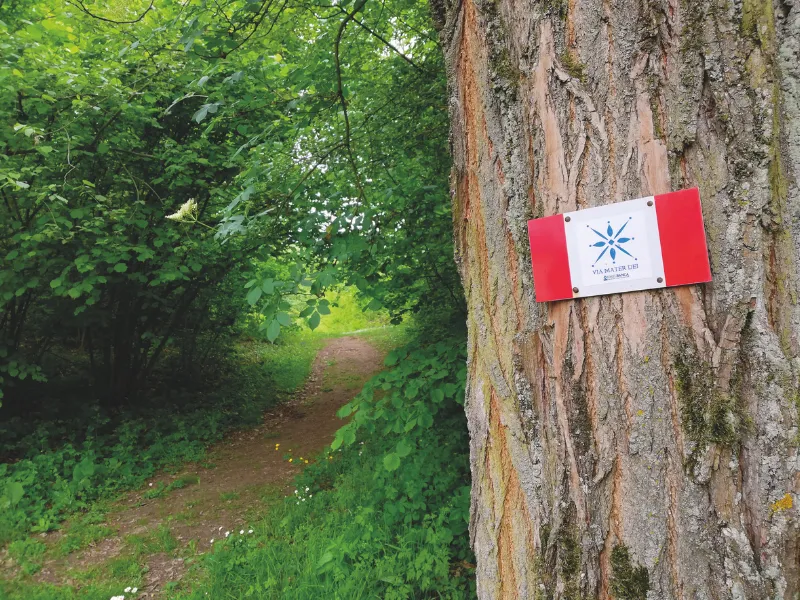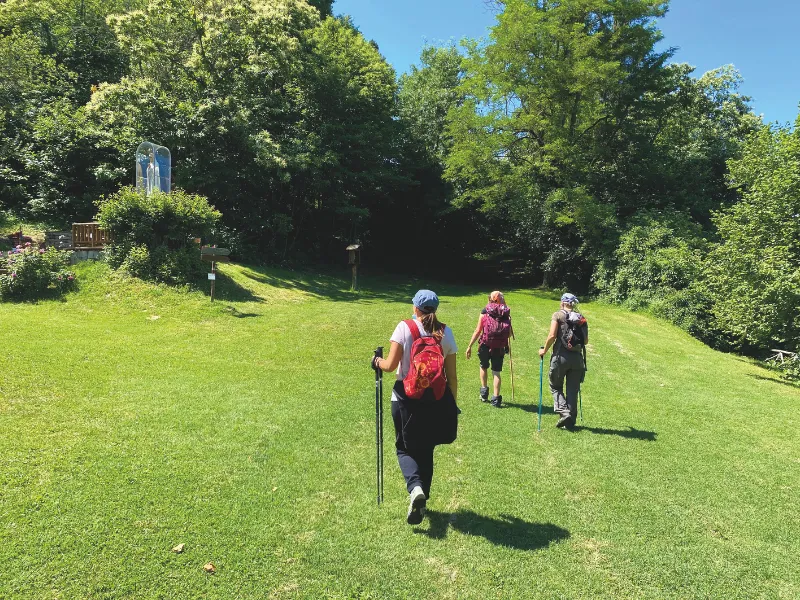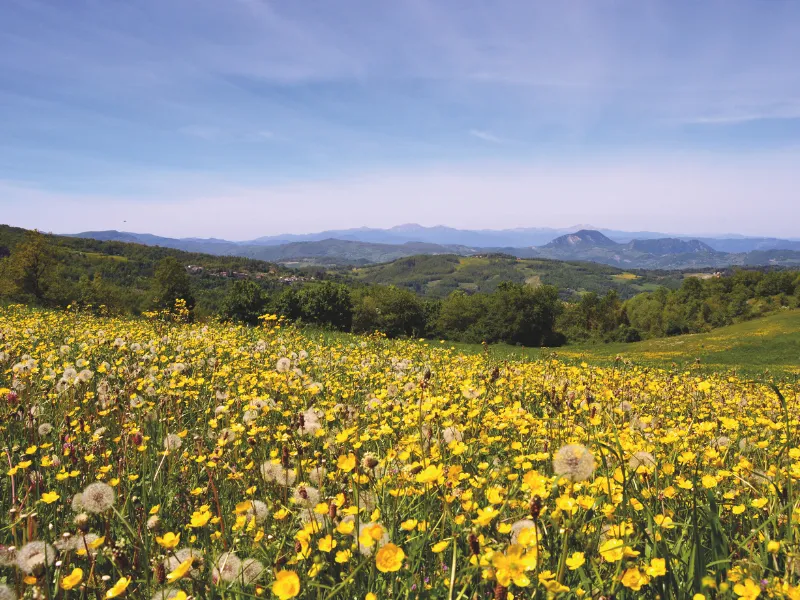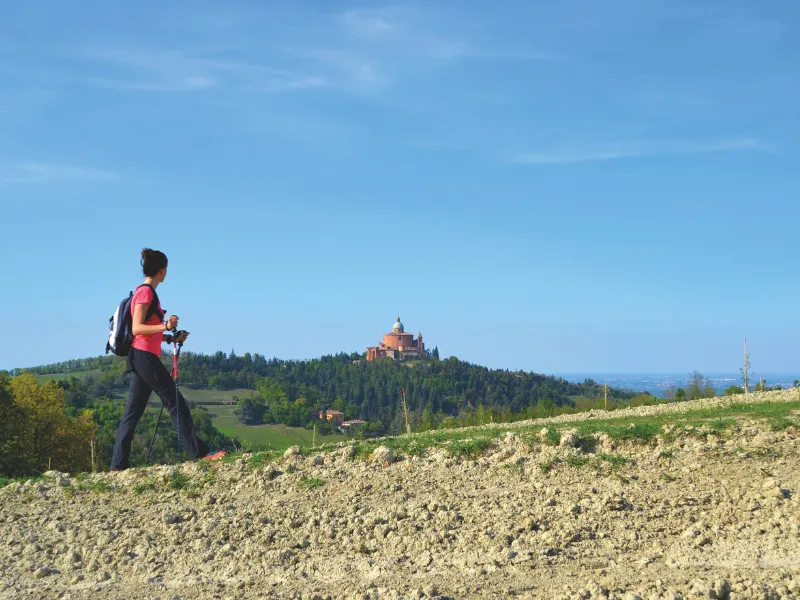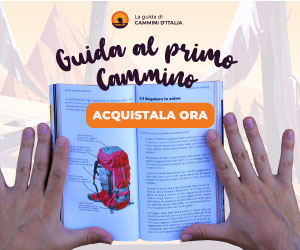
Via Mater Dei
The Via Mater Dei is a path of medium difficulty that connects, starting from Bologna, some of the main Marian shrines of great beauty and charm found in the Bolognese Apennines.
Passing through places of enormous richness in many aspects, landscape and naturalistic, but also strongly characterized by the history, culture, tradition, archaeology and geology of these areas, it is possible to come into contact with great intensity with the people and places, villages, culture and food and wine tradition and not only of these territories. It is a journey that, therefore, can be lived both in a spiritual form and as a pure hiking experience, certain that it will still give great emotions. A path that never ceases to amaze, where the things to admire follow one another at a relentless pace, accompanying the walker in every step.
Data Sheet
-
Length:
157 km -
Stages:
7 -
Departure:
Bologna -
Arrival:
Riola di Vergato
HISTORY
The path has no historical roots: it is the brainchild of a group of people who wanted to give due prominence to the great wealth of Marian shrines in the territory of the Bolognese Apennines, seeking to encourage the revival of those most suffering from the abandonment of these lands. The route, however, was created not only to unite sacred places, but also aims to highlight sites of great historical, naturalistic, archaeological and geological interest that distinguish the Apennines, allowing the walker to come into direct contact with the people who populate them and their traditions of great hospitality. A great deal of work has been done, and is still ongoing, to involve local realities precisely because the Via Mater Dei was not created to be a link between two points, but must be experienced meter by meter. Efforts have also been made, as far as possible, to make the route functional to be walked in sections as well, so that it is to all intents and purposes a multi-thematic itinerary and not just a path. In 2021 the final route was arrived at, although some minor adjustments can always be made, while in 2022 the MTB route was defined, deviating only for short stretches from the walker route.
STAGE
STAGE 1: Bologna – Rastignano
20.4 km – 734m + / 705 m-
Travel time: about 7 hours
STAGE that is divided between the city and the hills. Start in the center of Bologna, in the picturesque Quadrilatero area, home to food stalls, typical stores and bustling bars and taverns, opposite the Sanctuary of Santa Maria della Vita. Crossing the center of the city, passing through Piazza Maggiore, Via d’Azeglio and Via Saragozza, one arrives at the Portico of San Luca, the longest in the world, which protects pilgrims ascending to the Basilica of the same name, the second sanctuary on the way. Here begins the crossing of the Colli Bolognesi, gentle landscapes and rich vegetation that accompany walkers through several parks, Cavaioni, Monte Paderno, Forte Bandiera and Paleotto, until the arrival of the first STAGE in Rastignano
STAGE 2: Rastignano – Zena (Pianoro)
20.4 km – 772m + / 675 m-
Travel time: about 7 hours and 30 minutes
STAGE that definitively leads out of the city, to immerse oneself in a truly uninhabited reality, the Zena Valley, with beautiful views. From the church of Rastignano we climb toward Monte Calvo, passing by the ancient Fornace and the Cemetery. At the top of the hill, in the presence of the altar dedicated to Mater Pacis, there is a beautiful 360-degree panorama, allowing views of much of the path, the Pliocene Spur and many areas that were the scene of fighting during World War II. From there we head into the valley, on the trail of Fantini, a key figure in the history of the Bolognese Apennines. Toward the end of the STAGE, pass through the charming abandoned village of Gorgognano and subsequent view of the site where a Whale from the Pliocene era was found, a place celebrated today by a sculpture depicting it.
Not a particularly challenging STAGE, but quite wild, with many uncovered sections and little water availability along the way, so it is essential to start well equipped to protect yourself from the sun and heat. At Brinello, with a short detour, it is possible to reach Botteghino di Zocca, where refreshment points can be found.
STAGE 3: Zena (Pianoro) – Loiano
22.6 km – 1355m + / 849 m-
Travel time: about 8 hours and 30 minutes
Very challenging STAGE, but characterized by a great wealth of points of interest and beautiful views. From Zena you will climb for a good stretch to head towards the Sanctuary of Monte delle Formiche. Along the way you will pass near the ancient Castle of Zena, the Heir’s Tower and the hamlet of Tazzola, which is home to the truly distinctive Botroid Museum, which is definitely worth a visit. After the Sanctuary, a beautiful stretch of very scenic ridge, followed by a descent and an ascent leading to the small village of Castelnuovo di Bisano, where there is a small but charming little church dedicated to St. John the Baptist. A little further on you pass through the beautiful Monte Bibele Archaeological Nature Area, with a service center and reconstruction of an Etruscan-Celtic settlement, before arriving at Quinzano and from there taking the final climb to Loiano (possible shortening by taking regular buses).
STAGE 4: Loiano – Madonna dei Fornelli
25.4 km – 1116m + / 1091 m-
Travel time: about 9 hours
STAGE full of shrines and points of interest, in which you really begin to appreciate the Apennine landscape, among ridges, valleys, oak, beech and ancient chestnut forests. From Loiano we head toward the Astronomical Observatory, where it is worth wandering a bit among the various buildings and descriptive signs. A descent leads toward Gragnano and its beautiful Church of Santa Maria Assunta, then to Campeggio, which houses a faithful reproduction of the grotto of Lourdes, passing on the way to the hamlet of Sumbilla and ascending on the Way of the Cross path to Monte Calvario. Then it’s on to the Sanctuary of Madonna dei Boschi, guarded with incredible passion by the friars, and shortly after to Monghidoro. From here begins the descent toward the Savena valley, passing through Piamaggio, home to the Sanctuary of the Madonna of Pompei and two small but very interesting museums, to the lake of Castel dell’Alpi. A final short climb leads to the arrival at Madonna dei Fornelli, the junction point with Via degli Dei.
STAGE 5: Madonna dei Fornelli – Bruscoli – Baragazza
24.2 km – 966m + / 1080 m-
Travel time: about 9 hours
A fascinating STAGE, where small villages alternate with forests and open spots with beautiful views of the Apennine mountains, especially Mount Cimone and Corno alle Scale. An intermediate station and the only STAGE point in Tuscany is the village of Bruscoli. From Madonna dei Fornelli you head toward the quaint village of Qualto, and following that you pass near Montefredente and then toward Ca “de” Santoni, seeing the characteristic church of Pian del Voglio on your right. You pass through a beautiful forest of beech and fir trees to enter Tuscany and arrive at Bruscoli, which offers many sights worth staying for, such as the Museum of the Gothic Line (visitable by appointment). The path then continues downhill along the course of the Biscione stream, with its beautiful waterfalls, and then of the Gambellato, to be crossed at a beautiful farmhouse, following a section of the Alta Via dei Parchi to reach Roncobilaccio. An evocative climb leads to the magical Boccadirio Sanctuary, located near the stage finish in Baragazza.
STAGE 6: Baragazza – Ripoli
25.2 km – 988m + / 1124 m-
Travel time: about 9 hours
Another STAGE extremely rich in points of interest, with exceptional views accompanying throughout the first part and historical and cultural suggestions during the second. From Baragazza we set off in the direction of Castiglione dei Pepoli, skirting Poggio Castello and descending to a fascinating mill, where we cross the Setta River. The ascent offers passage to Ca’ di Landino, a place of great historical significance, linked to the construction of the Bologna-Florence Direttissima railway. Once in Castiglione dei Pepoli, take the scenic ridge that leads to Monte Catarelto, a place as beautiful from a scenic point of view as it is important in relation to World War II. It then descends to Lagaro, with its ancient history, before a final climb to Ripoli, with the charming village of Serrucce, ending at the Sanctuary of Santa Maria della Serra.
STAGE 7: Ripoli – Riola di Vergato
22.4 km – 833m + / 1118 m-
Travel time: about 8 hours and 30 minutes
Grand finale, with an extremely pleasant STAGE rewarded by the beautiful views toward Montovolo and Monte Vigese that gradually approach. The first part skirts the Brasimone stream and the many mills that exploited its waters in the past, then climbs toward the Sanctuary of Montovolo, located in a unique place that also houses the Oratory of Santa Caterina d’Alessandria and a path related to the Salvemini School tragedy, on which a military plane crashed, killing 12 boys. The descent to Riola di Vergato is full of attractions, from the perfectly preserved historic villages of Gli Sterpi and La Scola to Rocchetta Mattei, a truly unique castle. On arrival, the church designed by Finnish architect Alvar Aalto, dedicated to St. Mary of the Assumption, to welcome walkers as they arrive Via Mater Dei.
WATER SOURCES.
Apart from the villages, there are several water supply points and almost all of them are indicated on the mapguide and on the trail. The only STAGE that presents a minimum of criticality in this respect is the second one, for which it is absolutely necessary to start well equipped.
STAGE-BY-STAGE SERVICES
Are there any supermarkets?
Grocery and general stores are present at all STAGE points except Zena. Grocery stores are present in almost all the villages traversed.
Are there any pharmacies?
Along the way there are pharmacies in Bologna, Rastignano, Loiano, Monghidoro, Baragazza, Castiglione dei Pepoli, and Riola di Vergato, while in Madonna dei Fornelli it is possible to buy ancillary products, such as plasters, creams, etc.
DANGERS
Sheepdogs in Zena Valley, 5th STAGE Gullies: should be checked at Bruscoli what condition the streams are in and possibly do the variant shown on the map.
TENT WALK
As in the entire region, camping is not allowed outside of equipped areas, while bivouacking is possible. Some facilities provide space for tents.
CREDENTIALS
Pilgrim’s credential available by contacting Foiatonda cooperative or at tourist information offices in Bologna and Madonna dei Fornelli
ROAD BOTTOM.
39% asphalt, the rest is divided between dirt roads and trails
